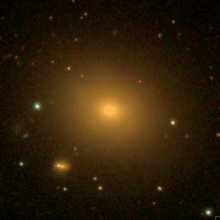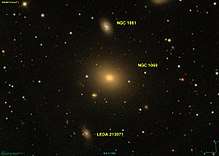NGC 1060
| NGC 1060 | |
|---|---|
 NGC 1060 (SDSS) | |
| Observation data (J2000.0 epoch) | |
| Constellation | Triangulum |
| Right ascension | 02h 43m 15.05s [1] |
| Declination | +32° 25′ 29.90″ [1] |
| Redshift | 0.017312 [1] |
| Helio radial velocity | 5190 ± 22 km/s [1] |
| Distance | 256 Mly [1] |
| Apparent magnitude (V) | 12.00 [2] |
| Apparent magnitude (B) | 13.00 [2] |
| Characteristics | |
| Type | S0 [1] |
| Apparent size (V) | 2.3 x 1.7 [1] |
| Other designations | |
| PGC 10302, MCG 5-7-35, UGC 2191 | |
NGC 1060 is a lenticular galaxy approximately 256 million light-years away from Earth in the constellation of Triangulum.[1] It was discovered by William Herschel on September 12, 1784.[3]

NGC 1060 is the brightest member of the galaxy group LGG 72, which contains ~15 galaxies.[4][5] Intergalactic medium (IGM) in this system is highly disturbed, with separate X-ray peaks centred on the two main galaxies of the group, NGC 1060 and NGC 1066.[4] A ∼250 kpc arc of hot gas is linking these two galaxies.[4] The system appears to be undergoing a merger, which may have triggered the nuclear activity in NGC 1060.[4][5]
In 2013 a small-scale (20”/7.4 kpc) jet source was detected in NGC 1060, indicating a remnant of an old, low power outburst.[4] The radio emission which arises from this jet was also detected.[6][5]
NGC 1060 is an active galaxy, with confirmed active galactic nucleus (AGN).[6]
Supernova SN 2004fd
Supernova SN 2004fd of magnitude 15.70 was detected in NGC 1060 on October 22, 2004.[7] It was discovered by Tom Boles who was using 0.35m Schmidt-Cassegrain telescope during searches for the UK Nova/Supernova Patrol.[7] The supernova was classified as type Ia, and was located very close to the nucleus of its host galaxy (the J2000 epoch celestial coordinates: RA 02h 43m 15.20s, Dec +32° 25′ 26.00″).[8][1]
See also
External links
- NGC 1060 on WikiSky: DSS2, SDSS, GALEX, IRAS, Hydrogen α, X-Ray, Astrophoto, Sky Map, Articles and images
- SEDS
References
- 1 2 3 4 5 6 7 8 9 "NASA/IPAC Extragalactic Database". ned.ipac.caltech.edu. Retrieved December 7, 2017.
- 1 2 "Revised NGC Data for NGC 1060". spider.seds.org. Retrieved December 9, 2017.
- ↑ "Data for NGC 1060". www.astronomy-mall.com. Retrieved December 9, 2017.
- 1 2 3 4 5 Kolokythas, K.; et al. (2014). "Radio properties of nearby groups of galaxies". In Chengalur, J. N. Proceedings of the Metrewavelength Sky conference. Astronomical Society of India. arXiv:1402.5109v1. Bibcode:2014ASInC..13..197K.
- 1 2 3 Vrtilek, Jan M; O'Sullivan, E; David, L. P; Kolokythas, K; Giacintucci, S; Raychaudhury, S; Ponman, T. J (2013). "CLoGS - the Complete Local-Volume Groups Survey". American Astronomical Society. 13: 116.06. Bibcode:2013HEAD...1311606V.
- 1 2 O’Sullivan, E.; et al. (2015). "Cold gas in group-dominant elliptical galaxies". Astronomy and Astrophysics. 573: A111. arXiv:1408.7106. Bibcode:2015A&A...573A.111O. doi:10.1051/0004-6361/201424835.
- 1 2 "THE ASTRONOMER Electronic Circular No 2056". www.theastronomer.org. Retrieved December 7, 2017.
- ↑ "Supernova 2004fd in NGC 1060". www.rochesterastronomy.org. Retrieved December 7, 2017.